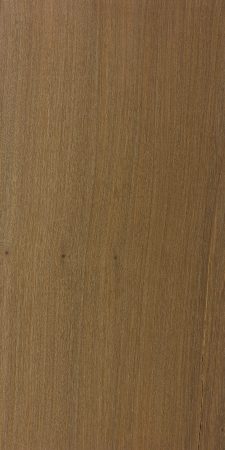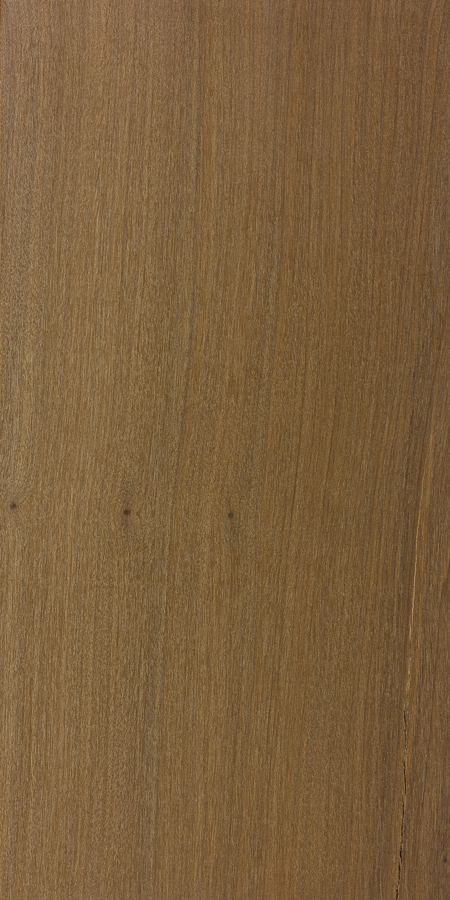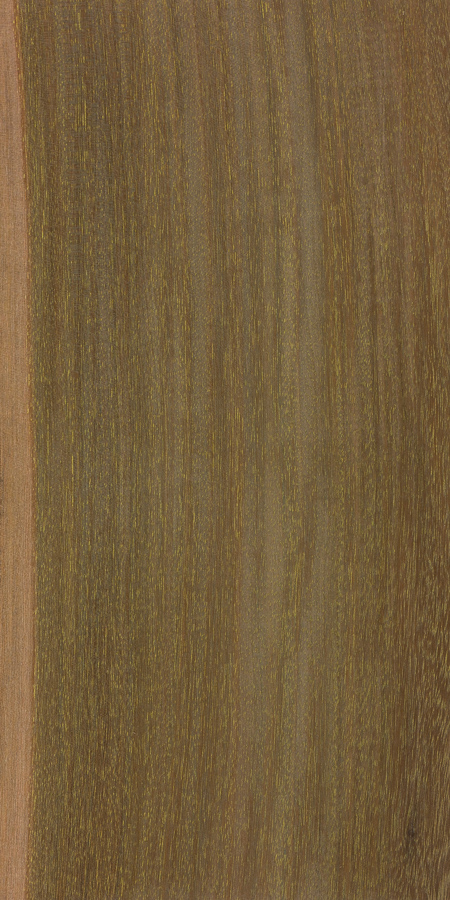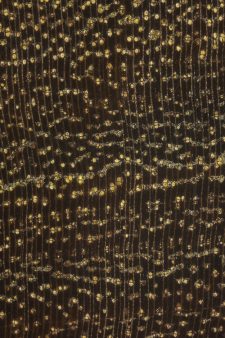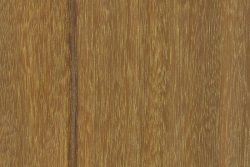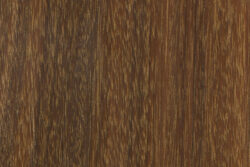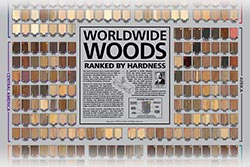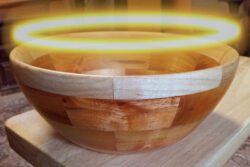DATA SOURCE(S): 20,28,30,39
Common Name(s): Pink lapacho, ipe, pink trumpet tree
Scientific Name: Handroanthus impetiginosus, formerly in the Tabebuia genus as Tabebuia impetiginosa; T. palmeri is another common synonym of this species
Distribution: Mexico, south to Central and South America
Tree Size: 65-100 ft (20-30 m) tall,
1-2 ft (.3-.6 m) trunk diameter
Average Dried Weight: 59.9 lbs/ft3 (960 kg/m3)
Specific Gravity (Basic, 12% MC): .89, .96
Janka Hardness: 2,660 lbf (11,850 N)
Modulus of Rupture: 23,210 lbf/in2 (160.1 MPa)
Elastic Modulus: 2,773,000 lbf/in2 (19.13 GPa)
Crushing Strength: 10,600 lbf/in2 (73.1 MPa)
Shrinkage: Radial: 4.3%, Tangential: 7.2%,
Volumetric: 11.6%, T/R Ratio: 1.7
Color/Appearance: Heartwood tends to be medium to dark brown; sometimes with contrasting darker brown/black stripes. Pink lapacho’s name derives from the color of its flowers, not the color of its heartwood. Overall appearance can be very similar to cumaru (Dipteryx odorata).
Grain/Texture: Has a fine to medium texture, with the grain varying from straight to irregular or interlocked. Moderate natural luster.
Rot Resistance: Rated as very durable; with excellent insect resistance.
Workability: Overall, pink lapacho is a difficult wood to work, being extremely hard and dense, with high cutting resistance during sawing. It also has a pronounced blunting effect on cutting edges. The wood generally planes smoothly, but the grain can tearout on interlocked areas. Also, pink lapacho can be difficult to glue properly, and surface preparation prior to gluing is recommended. Straight-grained wood turns well, though the natural powdery yellow deposits (called lapachol) can sometimes interfere with polishing or finishing the wood.
Odor: Pink lapacho has a mild scent while being worked.
Allergies/Toxicity: Many Handroanthus species contain lapachol (and related substances like lapachenole and deoxylapachol), which have been observed to produce pronounced irritant responses on skin.[1]Schulz, K. H., Garbe, I., Hausen, B. M., & Simatupang, M. H. (1977). The sensitizing capacity of naturally occurring quinones. Experimental studies in guinea pigs. I. Naphthoquinones and related … Continue reading Although severe reactions are quite uncommon, Handroanthus species have been reported to cause skin, eye, and respiratory irritation, as well as other effects such as headaches, asthma-like symptoms,[2]Algranti, E., Mendonça, E. M., Ali, S. A., Kokron, C. M., & Raile, V. (2005). Occupational asthma caused by Ipe (Tabebuia spp) dust. Journal of investigational allergology & clinical … Continue reading and/or disturbance of vision. See the articles Wood Allergies and Toxicity and Wood Dust Safety for more information.
Pricing/Availability: Primarily sold as decking or flooring, individual boards for furniture or general use are sometimes available as well. Prices are in the medium range for an imported tropical species. Though with ipe’s 2024 listing in the CITES Appendix II, availability is expected to steadily diminish, and prices to increase.
Sustainability: Pink lapacho is listed in the CITES Appendix II under a blanket restriction spanning multiple genera (including Handroanthus, Tabebuia, and Roseodendron). Handroanthus impetiginosus is also reported by the IUCN as being near threatened. Technically it doesn’t meet the Red List criteria of a vulnerable or endangered species, but is close to qualifying and/or may qualify in the near future.
But aside from the immediacy of any threats to Handroanthus, these tree species tend to grow in very low densities, with mature trees only occurring once per 300,000 to 1,000,000 square feet (3 to 10 hectares) of forest area. This necessitates the clearing of large sections of rainforest trees, most of which, after factoring in the cost of transportation, have little to no commercial value.[3]Hutton, J. (2013). A Trail of Stumps. Landscape Architecture Magazine, 103(5), 117-126.
Common Uses: Flooring, decking, exterior lumber, veneer, tool handles, and other turned objects.
Comments: Pink lapacho (Handroanthus impetiginosus) is harvested and sold interchangeably with H. serratifolius under the generic commercial name ipe, though the lumber is usually referred to by the halo name ‘Brazilian walnut’ among flooring dealers—but it’s not related to true walnut in the Juglans genus. When compared to the more widely harvested H. serratifolius, the wood of H. impetiginosus tends to be slightly lighter in weight, and accordingly slightly weaker, on average, in nearly all mechanical measurements.
Formerly placed in the Tabebuia genus, species of ipe (H. guayacan, H. impetiginosus, H. serratifolius) were moved to the Handroanthus genus in 2007 based on genetic studies.[4]Grose, S. O., & Olmstead, R. G. (2007). Evolution of a charismatic neotropical clade: Molecular phylogeny of Tabebuia sl, Crescentieae, and allied genera (Bignoniaceae). Systematic … Continue reading
While Brazil exports the majority of commercial ipe, other regions also have Handroanthus species yielding similar lumber, though they are less commonly exported. When used locally, Handroanthus and Tabebuia trees are very highly regarded (several are included as national trees in their native habitat, including the nations of Paraguay, Venezula, and El Salvador). In this context, they are usually distinguished by the color of their very dramatic and widespread trumpet-like flowers, and are sometimes referred to as trumpet trees. Common flower colors include yellow (H. serratifolius and H. guayacan) and pink (H. impetiginosus and H. heptaphyllus).
Images: Drag the slider up/down to toggle between raw and finished wood.
The first sample is Handroanthus impetiginosus, while the second sample (with sapwood) was originally labeled as Tabebuia palmeri—later classified as a synonym of H. impetiginosus.
Identification: See the article on Hardwood Anatomy for definitions of endgrain features.
Porosity: diffuse porous; growth rings not visible
Arrangement: solitary and radial multiples
Vessels: medium to large, few to moderately numerous; tyloses and other colored mineral deposits common
Parenchyma: visible parenchyma is usually minimal, but can be unilateral, winged, and marginal
Rays: narrow, normal spacing; rays not visible without magnification
Lookalikes/Substitutes: Cumaru (Dipteryx odorata), is another dense South American timber with very similar appearance and anatomy. However, cumaru tends to be slightly lighter in color, and has a characteristic vanilla/cinnamon scent while being worked (in contrast, ipe tends to have a more resinous odor).
Notes: None.
Related Content:
References[+]
| ↑1 | Schulz, K. H., Garbe, I., Hausen, B. M., & Simatupang, M. H. (1977). The sensitizing capacity of naturally occurring quinones. Experimental studies in guinea pigs. I. Naphthoquinones and related compounds. Archiv fur dermatologische Forschung, 258(1), 41–52. |
|---|---|
| ↑2 | Algranti, E., Mendonça, E. M., Ali, S. A., Kokron, C. M., & Raile, V. (2005). Occupational asthma caused by Ipe (Tabebuia spp) dust. Journal of investigational allergology & clinical immunology, 15(1), 81–83. |
| ↑3 | Hutton, J. (2013). A Trail of Stumps. Landscape Architecture Magazine, 103(5), 117-126. |
| ↑4 | Grose, S. O., & Olmstead, R. G. (2007). Evolution of a charismatic neotropical clade: Molecular phylogeny of Tabebuia sl, Crescentieae, and allied genera (Bignoniaceae). Systematic Botany, 32(3), 650-659. |

